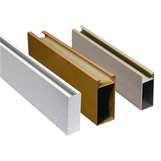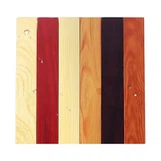As an established supplier of aluminum rectangular tubes, I've witnessed the growing demand for custom-sized solutions in various industries. Custom-sized aluminum rectangular tubes are crucial for projects that require specific dimensions to meet unique design and functional requirements. In this blog post, I'll guide you through the process of making custom-sized aluminum rectangular tubes, from the initial design phase to the final product.
Understanding the Basics of Aluminum Rectangular Tubes
Before delving into the custom-making process, it's essential to understand the basics of aluminum rectangular tubes. Aluminum is a popular choice for rectangular tubes due to its lightweight, corrosion resistance, and high strength-to-weight ratio. There are different aluminum alloys used for tubes, each with its own set of properties. For instance, 6063 Aluminum Rectangular Tube is known for its excellent extrudability and surface finish, making it suitable for architectural applications. Rectangle 6061 Aluminium Tubes offer good strength and weldability, and are commonly used in structural applications. 7050 Aluminium Rectangular Tube is a high-strength alloy often used in aerospace and high-performance engineering applications.
Step 1: Design and Specification
The first step in making a custom-sized aluminum rectangular tube is to define the design and specifications. This involves determining the exact dimensions (length, width, height, and wall thickness) of the tube, as well as the required alloy and temper. The design should be based on the specific application of the tube. For example, if the tube is for a structural support in a building, it needs to meet certain strength and load-bearing requirements. If it's for a decorative purpose, the surface finish and appearance may be more important.
You can work with a team of engineers or designers to create detailed drawings and specifications. These documents will serve as the blueprint for the manufacturing process and ensure that the final product meets your expectations.
Step 2: Material Selection
Once the design is finalized, the next step is to select the appropriate aluminum alloy. The choice of alloy depends on several factors, including the required strength, corrosion resistance, formability, and cost. As mentioned earlier, different alloys have different properties, so it's important to choose the one that best suits your application.
For example, if you need a tube with high corrosion resistance and good formability, 6063 aluminum may be a good choice. If strength is the primary concern, 6061 or 7050 aluminum might be more suitable. After selecting the alloy, you also need to determine the temper of the aluminum. The temper affects the hardness, strength, and ductility of the material.
Step 3: Extrusion Process
The most common method for manufacturing aluminum rectangular tubes is extrusion. Extrusion involves forcing heated aluminum billets through a die with the desired cross-sectional shape of the tube. The die is a precision tool that is custom-made to match the dimensions of the tube specified in the design.
Here's a general overview of the extrusion process:
- Billet Preparation: The aluminum billets are first heated to a specific temperature to make them more malleable. The heating temperature depends on the alloy and the extrusion process requirements.
- Extrusion Press: The heated billet is then placed in an extrusion press, where a ram applies pressure to force the billet through the die. As the aluminum passes through the die, it takes on the shape of the tube.
- Cooling and Sizing: After extrusion, the tube is cooled rapidly to set its shape. It is then cut to the desired length and may undergo additional sizing operations to ensure that it meets the exact dimensions specified in the design.
Step 4: Finishing Operations
Once the tube has been extruded, it may require additional finishing operations to improve its appearance and performance. Some common finishing operations include:
- Surface Treatment: Aluminum tubes can be treated with various surface finishes, such as anodizing, powder coating, or painting. Anodizing creates a protective oxide layer on the surface of the tube, improving its corrosion resistance and giving it a decorative appearance. Powder coating and painting can provide additional protection and allow for a wider range of color options.
- Machining: If the tube requires specific holes, slots, or other features, it may be machined using processes such as drilling, milling, or turning. Machining is used to achieve precise dimensions and tolerances that may not be possible through extrusion alone.
- Quality Inspection: Before the final product is shipped, it undergoes a thorough quality inspection to ensure that it meets all the specified requirements. This includes checking the dimensions, surface finish, and mechanical properties of the tube.
Step 5: Packaging and Delivery
After the tube has passed the quality inspection, it is packaged to protect it during transportation. The packaging method depends on the size and quantity of the tubes, as well as the shipping requirements. Common packaging materials include plastic wrap, cardboard boxes, and wooden crates.
Once the tubes are packaged, they are ready for delivery to the customer. As a supplier, we ensure that the tubes are delivered on time and in good condition.
Quality Control
Throughout the entire process of making custom-sized aluminum rectangular tubes, quality control is of utmost importance. Quality control measures are implemented at every stage, from material selection to the final inspection. This ensures that the tubes meet the highest standards of quality and performance.
We use advanced testing equipment and techniques to verify the mechanical properties, chemical composition, and dimensional accuracy of the tubes. This includes non-destructive testing methods such as ultrasonic testing and X-ray inspection, as well as destructive testing methods such as tensile testing and hardness testing.
Advantages of Custom-Sized Aluminum Rectangular Tubes
There are several advantages to using custom-sized aluminum rectangular tubes:
- Optimal Fit: Custom-sized tubes are designed to fit your specific application perfectly, eliminating the need for additional modifications or adaptations.
- Enhanced Performance: By choosing the right alloy and temper, you can ensure that the tubes have the required strength, corrosion resistance, and other properties for your application.
- Cost-Effective: Although custom-sized tubes may have a higher upfront cost compared to standard-sized tubes, they can save you money in the long run by reducing waste and improving efficiency.
Contact Us for Custom Aluminum Rectangular Tubes
If you're in need of custom-sized aluminum rectangular tubes for your project, we're here to help. As a leading supplier of aluminum rectangular tubes, we have the expertise and experience to provide you with high-quality custom solutions. Whether you need a small quantity for a prototype or a large order for a production project, we can meet your requirements.
Contact us today to discuss your project and get a quote. Our team of experts will work closely with you to understand your needs and provide you with the best possible solution.


References
- Aluminum Association. (2023). Aluminum Extrusion Technology.
- ASM Handbook Committee. (2017). ASM Handbook, Volume 2: Properties and Selection: Nonferrous Alloys and Special-Purpose Materials. ASM International.




